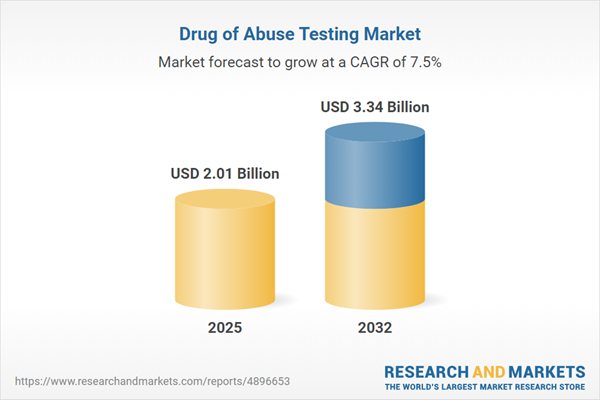Speak directly to the analyst to clarify any post sales queries you may have.
The Drug of Abuse Testing Market is experiencing significant transformation as innovation, regulatory change, and shifting end-user needs converge. Decision-makers are navigating a landscape marked by evolving test technologies, expanded use cases, and changing supply chain requirements.
Market Snapshot: Drug of Abuse Testing Market Growth Overview
According to recent research, the Drug of Abuse Testing Market grew from USD 1.87 billion in 2024 to USD 2.01 billion in 2025 and is forecast to reach USD 3.34 billion by 2032, driven by a CAGR of 7.49%. This sustained growth is supported by rising clinical demand for screening solutions, advances in analytical instrument platforms, and robust adoption across forensic and healthcare environments. Market expansion also reflects increased awareness around public safety, regulatory initiatives, and broader testing adoption within workplaces, hospitals, correctional facilities, and investigative agencies.
Scope & Segmentation: Comprehensive Market Coverage
- Sample Types: Hair, oral fluid, and urine for diverse detection windows and operational efficiency.
- Test Technologies: Chromatography (including GC-MS, LC-MS, LC-MS/MS, LC-QTOF) and immunoassay methods for both high-resolution analysis and high-throughput screening.
- End Users: Clinical laboratories, correctional facilities, forensic laboratories, and hospitals, each with specialized operational requirements.
- Drug Panels: Customized, expanded, five-panel, and ten-panel configurations to fit organizational policies and evolving substance profiles.
- Regional Segmentation: Americas (North America: United States, Canada, Mexico; Latin America: Brazil, Argentina, Chile, Colombia, Peru), Europe, Middle East & Africa (including key markets such as United Kingdom, Germany, France, Russia, UAE, South Africa), and Asia-Pacific (China, India, Japan, Australia, South Korea, Indonesia, Thailand, Malaysia, Singapore, Taiwan).
- Leading Companies: Thermo Fisher Scientific Inc., Roche Holding AG, Abbott Laboratories, Siemens Healthineers AG, Danaher Corporation, Bio-Rad Laboratories Inc., Hologic Inc., PerkinElmer Inc., Sysmex Corporation, Becton, Dickinson and Company.
Key Takeaways: Strategic Insights for Decision-Makers
- High-resolution mass spectrometry and immunoassay advances are elevating both accuracy and operational flexibility in laboratory workflows.
- Decentralized and near-patient testing models are gaining momentum, accelerating response times in clinical emergencies and correctional settings.
- Collaborations between manufacturers, vendors, and public sector agencies drive standardization and rapid adaptation to new psychoactive substances.
- Digital integration—including telemedicine, remote collection, and data connectivity—streamlines result management while maintaining chain-of-custody protocols.
- Segmentation highlights that choice of sample type and drug panel configuration strategically supports use-case specific demands and regulatory compliance.
- Customization of solutions and modular platform integration enable providers to serve a wide spectrum of testing environments and operational needs.
Tariff Impact: Navigating Trade and Supply Chain Complexities
Recent and emerging tariff policies in the United States have introduced notable challenges in sourcing analytical instruments and reagents. Laboratories and OEMs are adjusting by diversifying suppliers, renegotiating contracts, and seeking tariff-exempt production locations. Strategic partnerships and inventory investments are critical to minimizing operational disruptions. Enhanced local assembly and formulation initiatives improve supply chain resilience, while strong vendor relationships enable ongoing stability despite regulatory volatility.
Methodology & Data Sources: Ensuring Analytical Rigor
This report combines primary interviews with clinical, forensic, and correctional sector leaders and targeted surveys with comprehensive secondary research. Analytical frameworks map technology adoption, regulatory heterogeneity, and market maturity. Data are validated via cross-referencing vendor briefings and proficiency testing to deliver actionable, credible insights for stakeholders.
Why This Report Matters: Actionable Intelligence for Leaders
- Provides sector-specific trends and strategic forecasts aligned with evolving clinical, forensic, and regulatory landscapes.
- Empowers decision-makers to anticipate technology shifts, address supply chain risks, and align with global regulatory developments.
- Supports resource allocation, risk assessment, and innovation strategies for sustained competitive advantage in drug of abuse testing.
Conclusion
The Drug of Abuse Testing Market is positioned for dynamic growth as technologies develop and market participants respond strategically to new challenges. Senior leaders can leverage this report to inform operational, investment, and partnership decisions for sustained impact.
Additional Product Information:
- Purchase of this report includes 1 year online access with quarterly updates.
- This report can be updated on request. Please contact our Customer Experience team using the Ask a Question widget on our website.
Table of Contents
3. Executive Summary
4. Market Overview
7. Cumulative Impact of Artificial Intelligence 2025
Companies Mentioned
The companies profiled in this Drug of Abuse Testing market report include:- Thermo Fisher Scientific Inc.
- Roche Holding AG
- Abbott Laboratories
- Siemens Healthineers AG
- Danaher Corporation
- Bio-Rad Laboratories, Inc.
- Hologic, Inc.
- PerkinElmer, Inc.
- Sysmex Corporation
- Becton, Dickinson and Company
Table Information
| Report Attribute | Details |
|---|---|
| No. of Pages | 191 |
| Published | October 2025 |
| Forecast Period | 2025 - 2032 |
| Estimated Market Value ( USD | $ 2.01 Billion |
| Forecasted Market Value ( USD | $ 3.34 Billion |
| Compound Annual Growth Rate | 7.4% |
| Regions Covered | Global |
| No. of Companies Mentioned | 11 |









